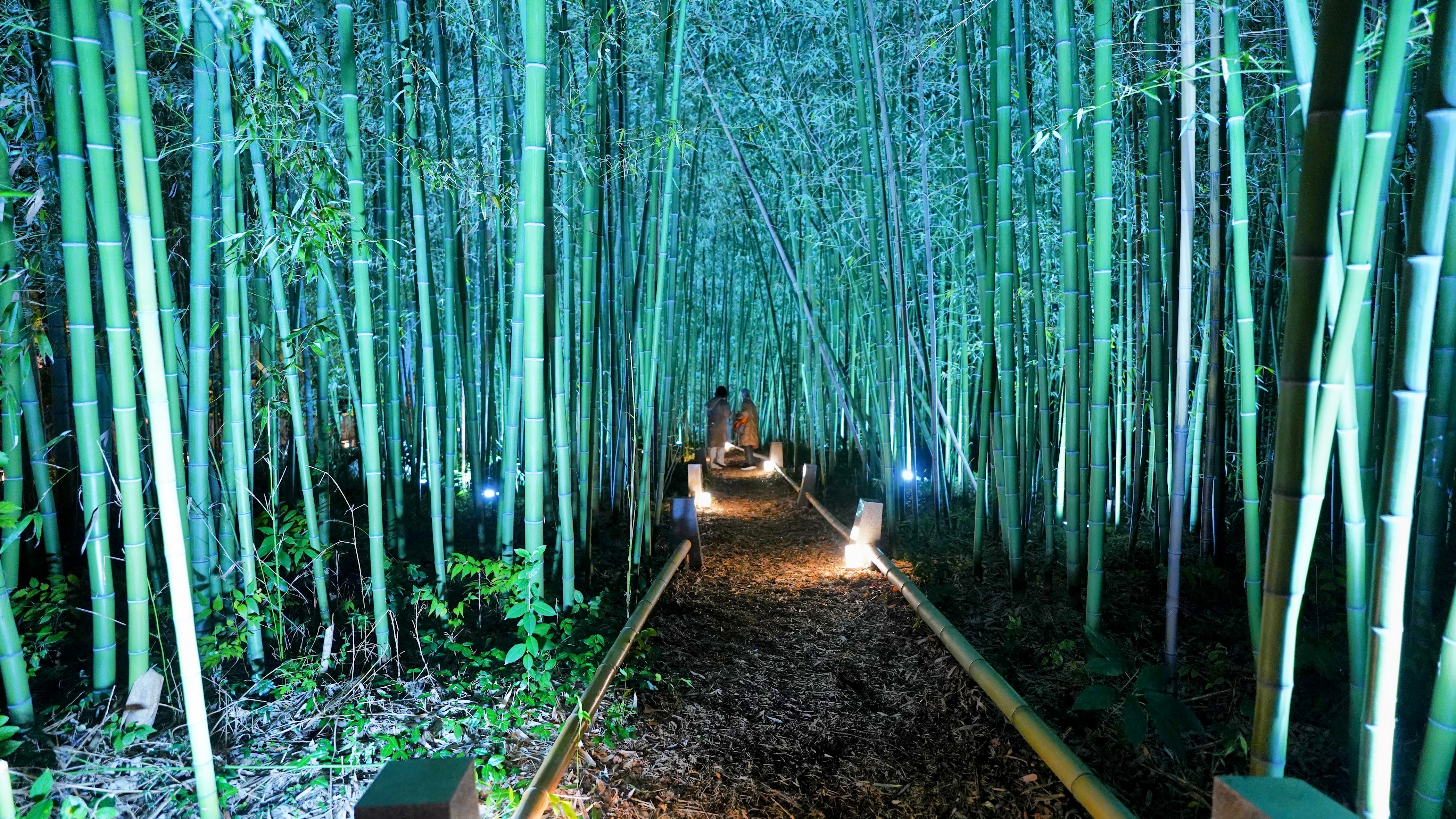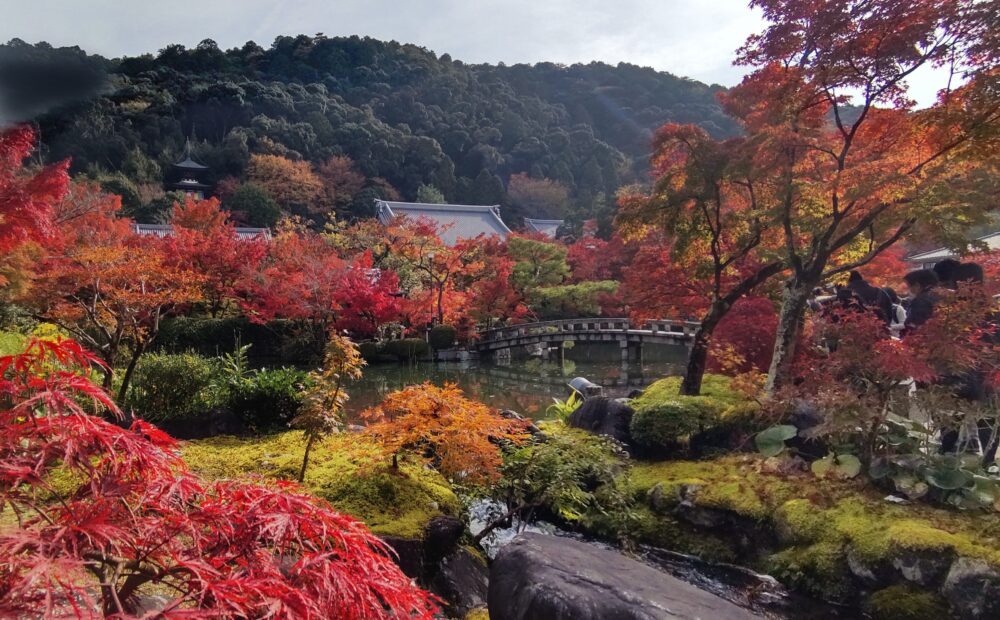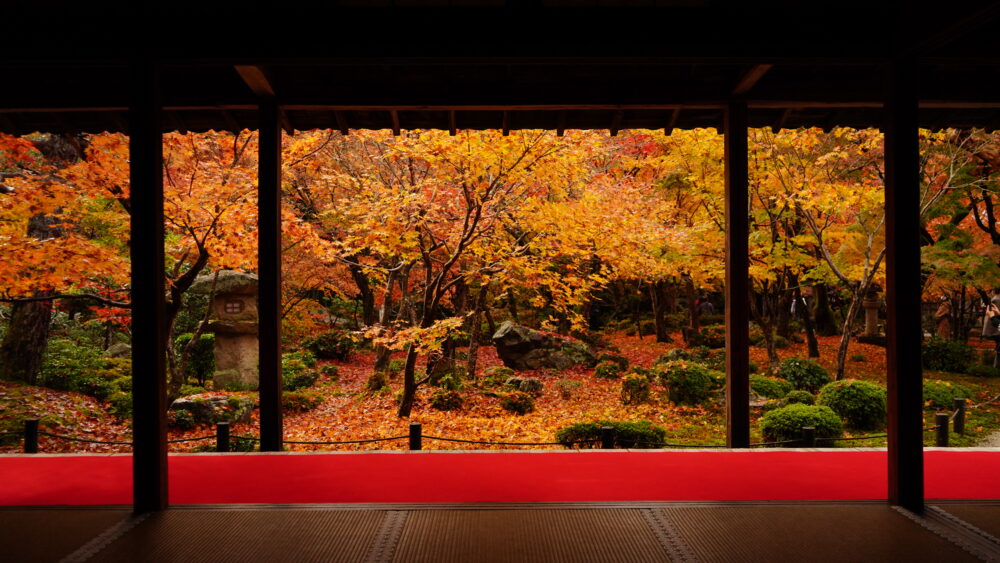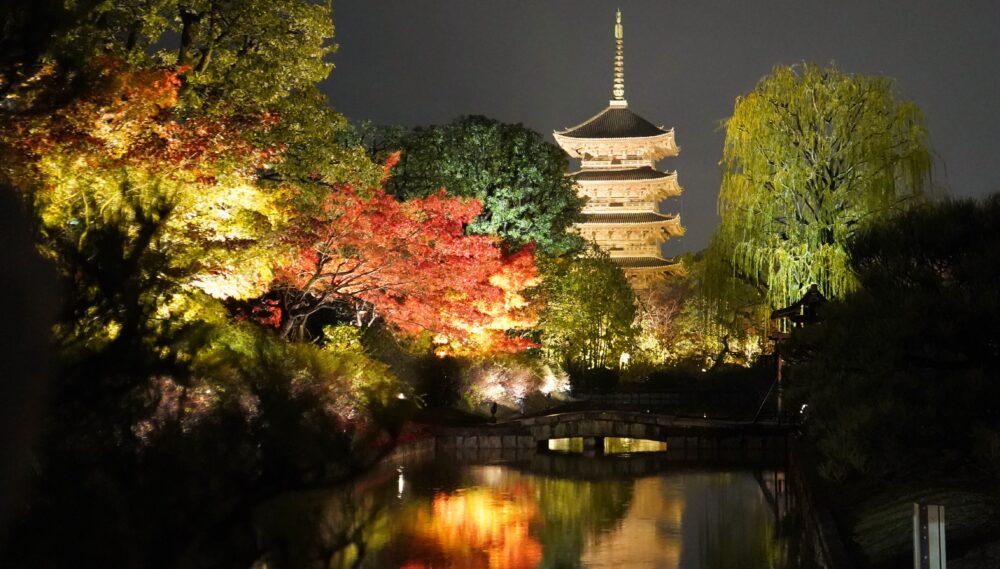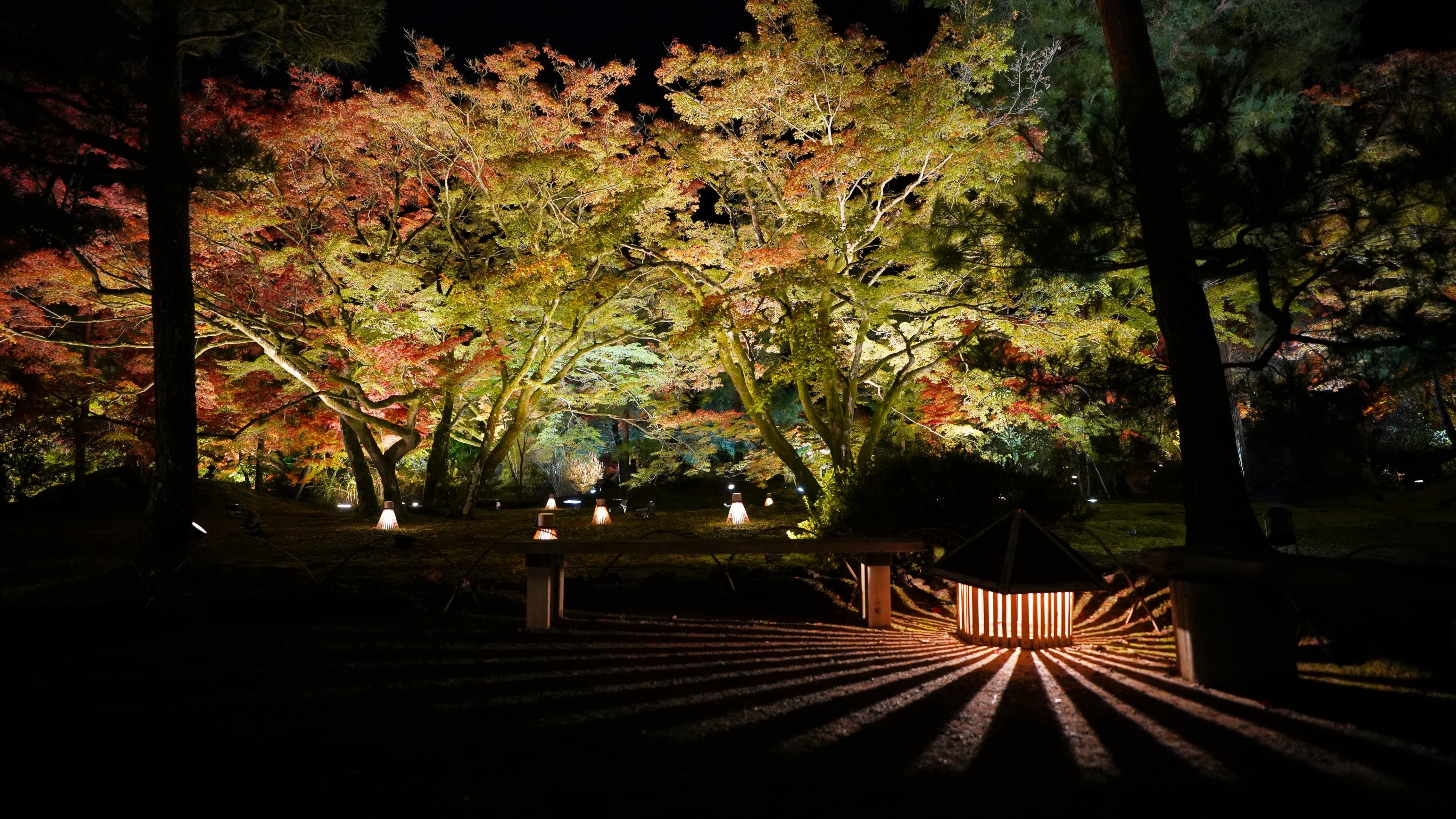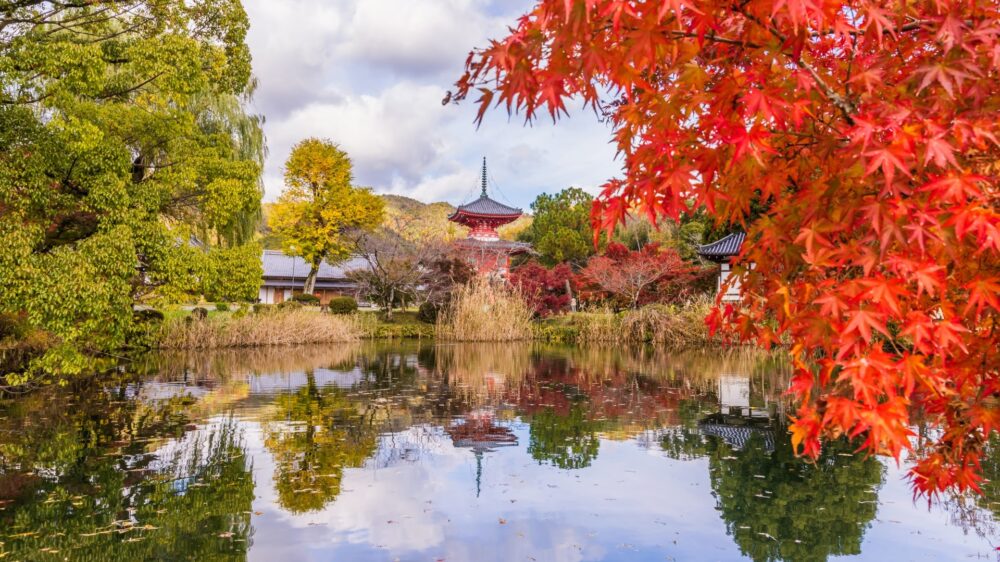Tenryu-ji Temple | Best time to visit in 2025
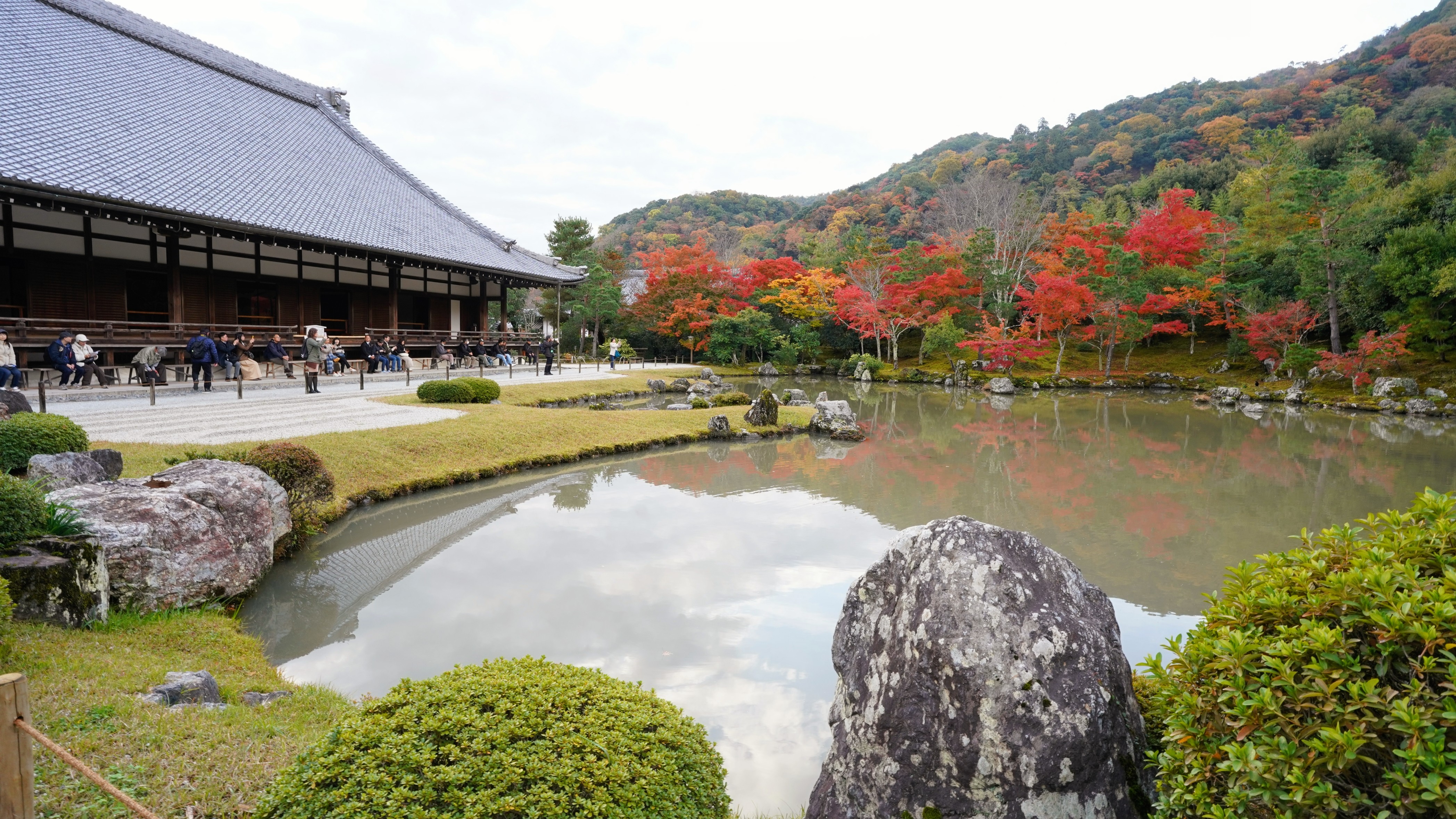
Arashiyama is one of the most popular tourist destinations in Kyoto. Tenryu-ji Temple, located in this area, is considered a top destination for visitors. While Arashiyama is bustling with tourists, Tenryu-ji offers a peaceful and serene atmosphere, making it a popular retreat for visitors.
Gardens
The Tenryu-ji Garden is a rare and invaluable example that preserves the ancient Japanese garden techniques established during the early Kamakura period almost completely.
Sogenchi Garden
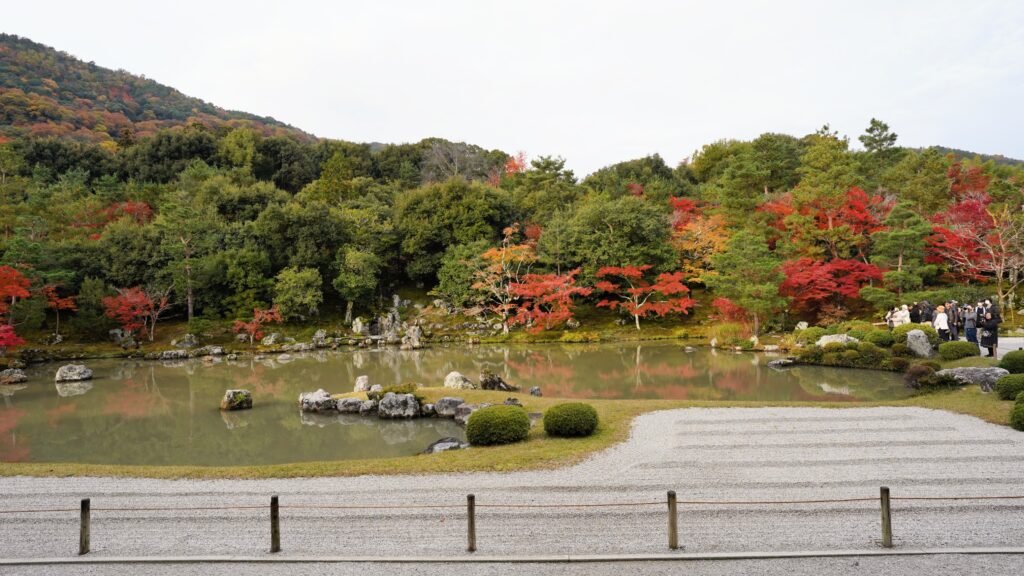
Sogenchi Garden, which covers approximately 4,300 square feet (4,000 square meters), is located adjacent to the Ohojo and is designed as a strolling pond garden, offering a serene view from the Ohojo. The garden features a Japanese dry garden symbolizing ripples of water, a small peninsula, and a turtle island in the pond. A cascading waterfall graces the southern end of the garden.
Waterfall stones and Standing stones

The garden’s greatest highlight is the unique sculptural beauty created by the combination of waterfall stones, standing stones, and rocky islets. These elements create illusions of depth and distance, offering ever-changing views depending on the angle from which they are observed. The main stone of the waterfall arrangement, located directly below the falls, is believed to act as a “guardian stone,” bringing prosperity to the garden and temple. There are also “three tiers of waterfall stones.”
Dejima(protruding islands)

The Dejima, or protruding islands, are strategically positioned on the northern and southern sides to add depth and variation to the landscape. The northern Dejima features a sturdy stone embankment that leads to a rocky islet where the lush green of Mt. Kame and the gentler green of Mt. Arashi come together, creating a stunning sense of depth. Though smaller, the southern Dejima is celebrated for the exquisite sculptural artistry of its stone arrangements. Comparing these distinct Dejima is said to significantly enrich the experience of appreciating the garden.
Stone Bridge and Rocky Islets

The waterfall stones and stone bridgee are uniquely beautiful. Composed of three nearly straight, flat natural stones, the stone bridge is extremely valuable as one of Japan’s oldest examples of a natural stone bridge. The rocky islet on the right supports the stone bridge, forming the overall sculptural beauty.
Ryumon and Carp Stone
The garden’s central stage, Ryumon (Dragon Gate), features a Carp Stone amidst a rushing current. Seeing this carp swim upstream is said to represent “Toryumon” (Climbing the Dragon Gate), telling the story of achieving unimaginable success and advancement through persistent effort. This embodies the Zen teaching that effort will be rewarded.
symbolism of Horai-san and Turtle Island
The Tenryu-ji Garden features “Turtle Island,” a symbol of longevity and prosperity. The garden is particularly significant because it is considered the origin of the “Turtle Horai style.” Rather than being an island, Turtle Island is shaped as part of the pond itself, linking to the Chinese belief that the immortals’ dwelling place rests on the back of a colossal turtle.
Hyakkaen Garden
Hyakkaen Garden, a walking garden established in 1983, is located in the northern section of Tenryu-ji Temple. Visitors are invited to stroll through the garden and enjoy the variety of seasonal blooms.
Best time to visit Tenryu-ji Temple
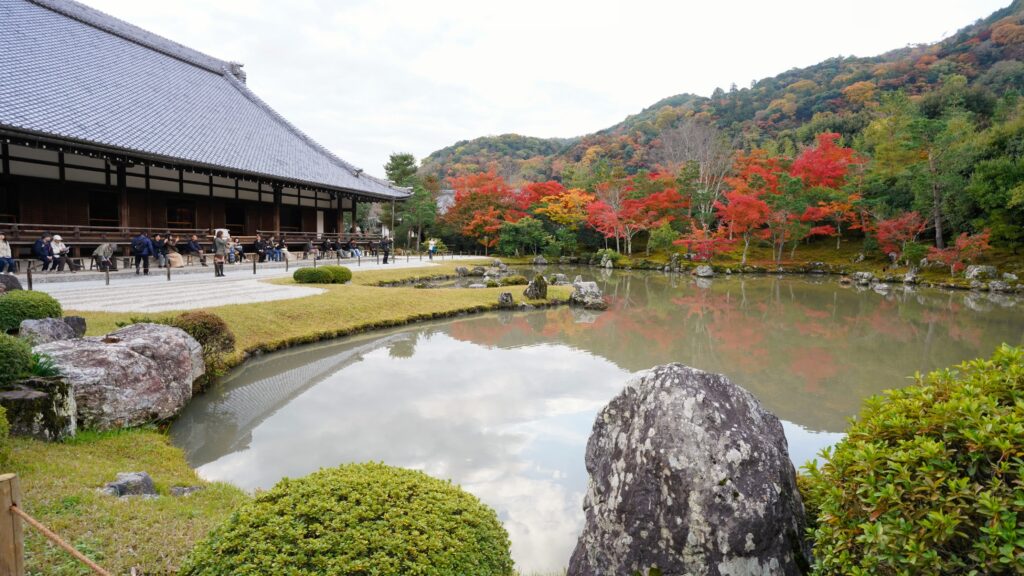
The best time to visit Tenryu-ji is in the fall. The Sogenchi Garden, especially with its fall foliage, is truly spectacular and attracts many visitors every year. The maple trees in the Sogenchi Garden are planted sparsely to complement the Arashiyama Mountains in the background. This creates a sense of unity between the garden and Mt. Arashiyama, resulting in a beautiful and peaceful view.
The peak foliage season in 2024 was from mid to late November, so it’s likely that the maple leaves will turn red around the same time in 2025. If you visit before the peak foliage season, you can enjoy turning red early at Tahoden Hall.
History
Tenryu-ji Temple was built in 1339 by Muso Soseki in memory of Emperor Godaigo. Soseki also created the Sogenchi Garden in 1343. However, a devastating fire swept through the temple in 1358, destroying most of the buildings. Although it was rebuilt, subsequent wars and fires led to repeated destruction.
In 1585, with the support of Toyotomi Hideyoshi, a full-scale reconstruction was undertaken. In 1876, Tenryu-ji became the head temple of the Rinzai Zen Tenryu-ji sect. Because of its historical significance, it was inscribed on the UNESCO World Heritage List in 1994.
Features
Tenryuji Temple, with its expansive grounds of approximately 330,000 square feet (100,000 square meters), houses the main temple and eleven sub-temples.
East Entrance
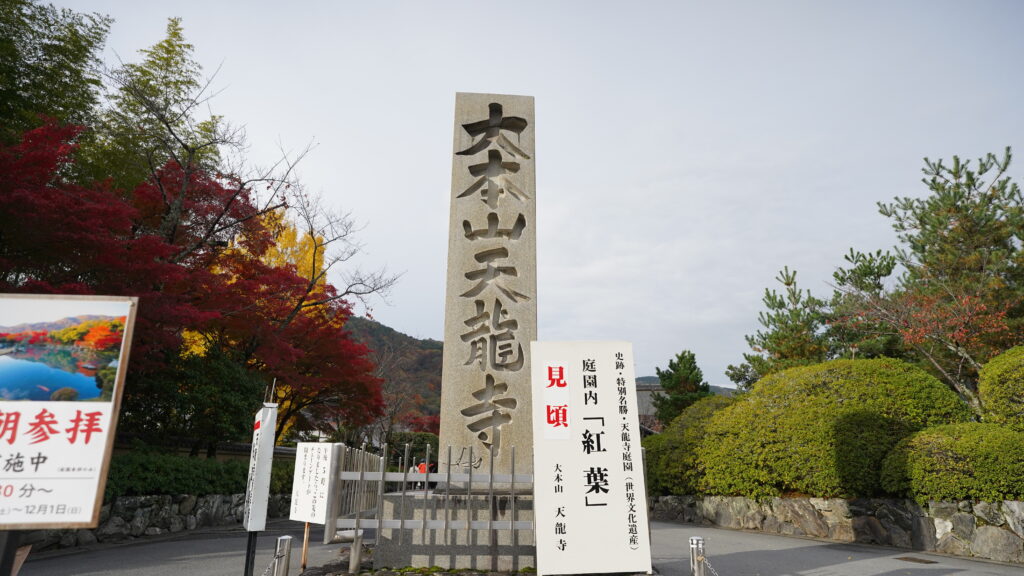
This is the east entrance to Tenryu-ji Temple, marked by a stone pillar. The east and north entrances are the main entrances, closest to Arashiyama Station on the Keifuku Electric Railway and Saga-Arashiyama Station on the JR Line. By walking straight for about 200 meters from the entrance, visitors reach the highlight of the temple: the main hall and the Japanese garden. If you want to see the sub-temples, it’s better to enter from the east entrance as they are close by.
North Entrance
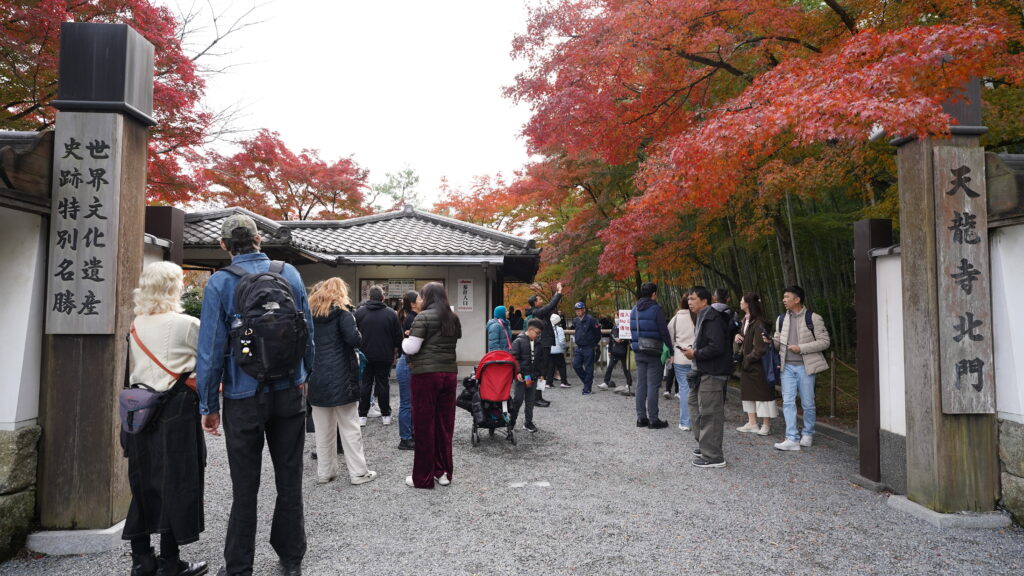
There is another entrance to Tenryu-ji Temple Group, the North Entrance, which is accessible from the bamboo forest. The north entrance tends to have shorter lines.
Large Hojo Hall(Abbot’s Quarters )
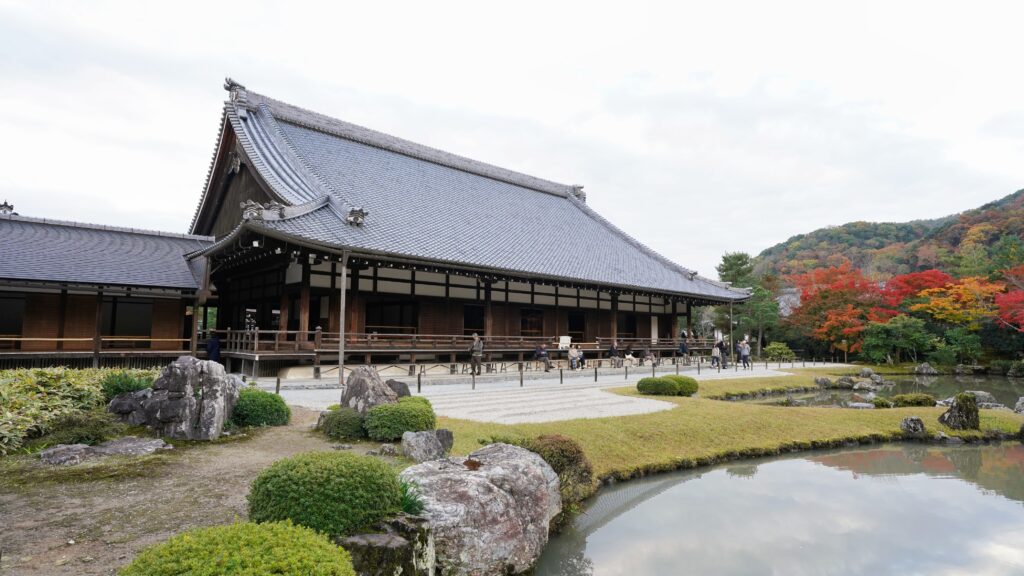
Large Hojo hall is the largest structure on the temple grounds, measuring approximately 98ft (30 meters) by 65ft (20 meters). It is located directly overlooking the Sogenchi Garden, providing visitors with a panoramic view of the serene landscape.
Hodo Hall
Hodo Hall is a Buddhist hall where the head priest delivers a Buddhist sermon. During special public viewings, visitors can marvel at the Unryu-zu, a magnificent cloud dragon painting that adorns the ceiling. Created in 1997 by renowned Japanese artist Kayama Matazo, the painting is known for its lifelike dragons that seem to look directly at the viewer from every angle.
Tahoden Hall
Tahoden Hall, Built in 1934, enshrines the statue of Emperor Go-Daigo and is surrounded by weeping cherry trees.
Other attractions near Tenryu-ji temple
Arashiyama Bamboo Forest
Arashiyama Bamboo Forest, a natural bamboo forest in Arashiyama, features a tranquil walking path that extends for approximately 1312ft (400m). Composed primarily of Moso bamboo, which can grow to over 65ft (20m) in height, the grove presents a captivating and ethereal ambiance.Located north of Tenryu-ji Temple, the grove provides a direct entrance to the north gate of the temple.
Okochi Sanso Garden
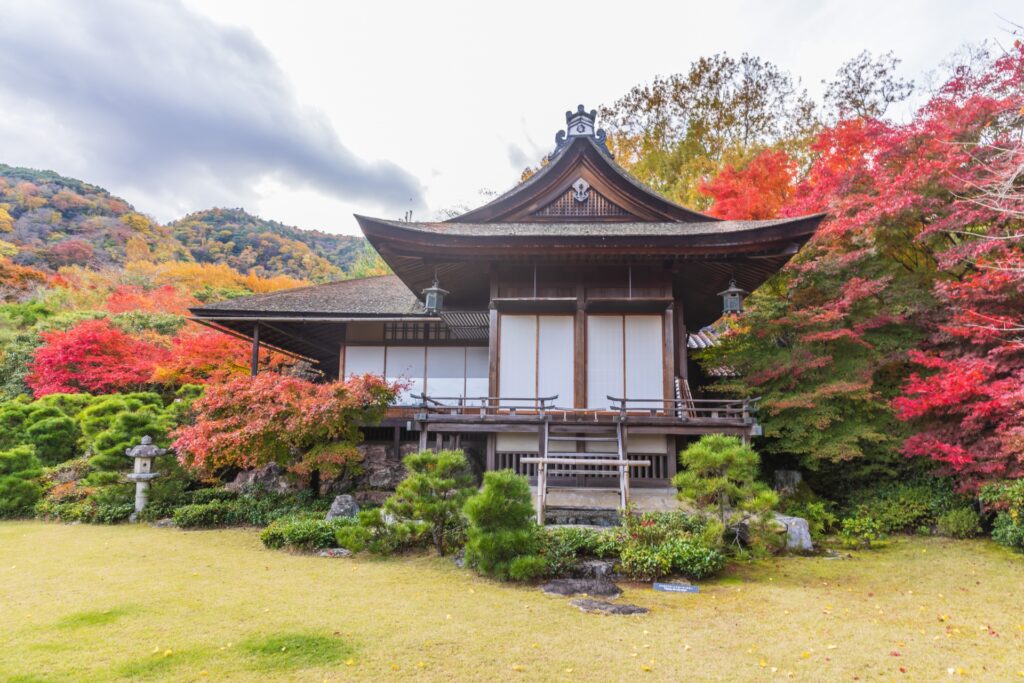
The Okochi Sanso Garden is a hidden gem located east of the Arashiyama Bamboo Grove. Covering approximately 24,000 yd2 (20,000 m2), this expansive garden was meticulously created over 30 years by renowned actor Denjiro Okochi as his private villa. The garden offers breathtaking panoramic views of the surrounding mountains, including Mt. Hiei and Arashiyama.
Tips to avoid crowds
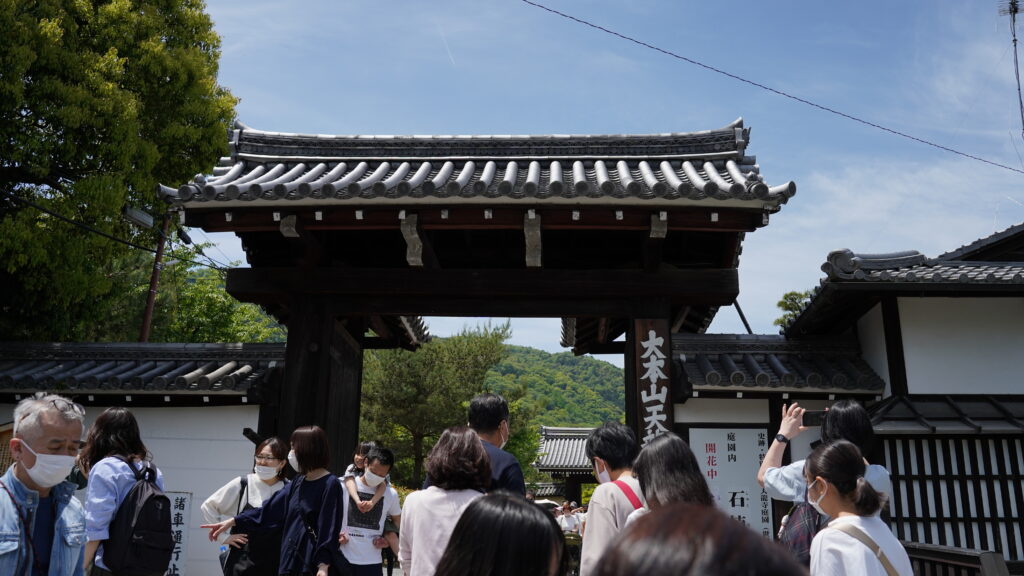
Arashiyama is a popular area, especially during the fall foliage season when many tourists visit. Tenryu-ji Temple in particular gets very crowded due to its beautiful fall-colored gardens. However, with some advance planning, you can avoid the crowds.
- Visit early in the early morning
It’s best to visit Tenryu-ji by 9 a.m., as the gates open at 8:30 a.m.
During the fall foliage season (mid to late November), early morning visits are available starting at 7:30 a.m., allowing you to enjoy the Sogenchi and Hyakkaen gardens.For early morning visits, visitors can only enter through the east gate, not the north gate. - Visit on a weekday
Weekdays are recommended as weekends and holidays tend to be crowded with local visitors.
Transportation tips
Travel by train and on foot
During the high season, traffic can be heavy. To ensure a timely arrival, it’s advisable to use public transportation (train) and walk to Tenryu-ji Temple.
- 2-minute walk from Arashiyama Station on the Keifuku Line
- 8-minute walk from Saga-Arashiyama Station on the JR Line
- 13-minute walk from Arashiyama Station on the Hankyu Line.
Information
Open hours
| Place | Period | Time |
|---|---|---|
| Sogenchi and Hyakkaen Gardens | Normal | 8:30a.m. – 5:00p.m.(Last Entry at 4:50p.m. ) |
| Novemebr.16th to December.1st | 7:30a.m. – 5:00p.m. at the East Reception 8:30a.m. – 5:00p.m. at the North Reception (Last Entry at 4:50p.m. ) | |
| Large Hojo Hall, Shoin Hall and Tahoden Hall | Holiday in October.29th and 30th | 8:30a.m. – 4:45p.m.(Last Entry at 4:30p.m.) |
| Hatto Hall(Cloud Dragon) | March.2nd to July.17th August.10th to 18th September.14th to December.1st (Except during the above-mentioned period, open only on Saturdays, Sundays, and national holidays) Holiday October.28th to 30th December.31st to January.2nd | 9:00a.m. – 4:30p.m.(Last Entry at 4:20p.m.) |
| September.1st and 7th to 13th | 9:00a.m. – 1p.m.(Last Entry at 0:50p.m.) |
Entrance Fee
| Place | Price |
|---|---|
| Sogenchi and Hyakkaen Garden | Adults : 500yen Elementary and junior high school students : 300yen Children under kindergarten age : Free |
| Large Hojo Hall, Shoin Hall and Tahoden Hall | Adults : 300yen Elementary and junior high school students : 300yen |
| Hatto Hall(Cloud Dragon) | 500 yen per person |
Address
〒616-8385 Kyoto, Ukyo Ward, Sagatenryuji Susukinobabacho, 68
Links & resources
Official Site
Tenryu-ji Temple(English text)
